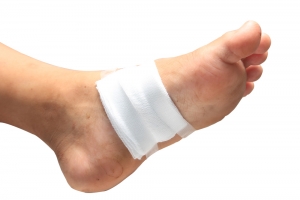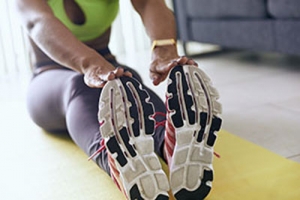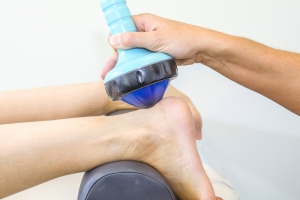Featured Articles

Wounds That Don't Heal Need to Be Checked
What Causes Gout?
 The medical term that is referred to as gout is considered to be a form of arthritis. Patients who develop this condition may often experience severe pain and discomfort in the big toe and surrounding areas, in addition to redness and swelling. Research has shown it may be caused by elevated uric acid levels in the blood, and this may be a result of eating foods that have large amounts of purines. These foods may include red meat, shellfish, and foods or drinks that are high in fructose. There are noticeable symptoms that are associated with gout, including stiffness in the affected joint, severe pain, and swelling. It may be possible to limit the occurrences of gout, and this may be accomplished by implementing lifestyle changes that may help to lower uric acid levels. Eating healthy foods and practicing a gentle exercise regime may help in maintaining a correct weight, which may be beneficial in possibly preventing gout attacks. If you are afflicted with gout, it is suggested to speak to a podiatrist who can properly treat this condition.
The medical term that is referred to as gout is considered to be a form of arthritis. Patients who develop this condition may often experience severe pain and discomfort in the big toe and surrounding areas, in addition to redness and swelling. Research has shown it may be caused by elevated uric acid levels in the blood, and this may be a result of eating foods that have large amounts of purines. These foods may include red meat, shellfish, and foods or drinks that are high in fructose. There are noticeable symptoms that are associated with gout, including stiffness in the affected joint, severe pain, and swelling. It may be possible to limit the occurrences of gout, and this may be accomplished by implementing lifestyle changes that may help to lower uric acid levels. Eating healthy foods and practicing a gentle exercise regime may help in maintaining a correct weight, which may be beneficial in possibly preventing gout attacks. If you are afflicted with gout, it is suggested to speak to a podiatrist who can properly treat this condition.
Gout is a painful condition that can be treated. If you are seeking treatment, contact one of our podiatrists from Romeo Foot & Ankle Clinic. Our doctors will treat your foot and ankle needs.
What Is Gout?
Gout is a form of arthritis that is characterized by sudden, severe attacks of pain, redness, and tenderness in the joints. The condition usually affects the joint at the base of the big toe. A gout attack can occur at any random time, such as the middle of the night while you are asleep.
Symptoms
- Intense Joint Pain - Usually around the large joint of your big toe, and it most severe within the first four to twelve hours
- Lingering Discomfort - Joint discomfort may last from a few days to a few weeks
- Inflammation and Redness -Affected joints may become swollen, tender, warm and red
- Limited Range of Motion - May experience a decrease in joint mobility
Risk Factors
- Genetics - If family members have gout, you’re more likely to have it
- Medications - Diuretic medications can raise uric acid levels
- Gender/Age - Gout is more common in men until the age of 60. It is believed that estrogen protects women until that point
- Diet - Eating red meat and shellfish increases your risk
- Alcohol - Having more than two alcoholic drinks per day increases your risk
- Obesity - Obese people are at a higher risk for gout
Prior to visiting your podiatrist to receive treatment for gout, there are a few things you should do beforehand. If you have gout you should write down your symptoms--including when they started and how often you experience them, important medical information you may have, and any questions you may have. Writing down these three things will help your podiatrist in assessing your specific situation so that he or she may provide the best route of treatment for you.
If you have any questions, please feel free to contact our offices located in Washington and Shelby Townships, MI . We offer the newest diagnostic and treatment technologies for all your foot care needs.
Gout
Gout is a form of arthritis that is caused by a buildup of uric acid crystals in the joints. This considered to be one of the most frequently recorded medical illnesses throughout history. Gout occurrences in the US have risen within the past twenty years and the condition now affects 8.3 million people which is 4% of all Americans. Researchers have found that gout affects men more than women and African-American men more than white men.
Symptoms of gout are warmth, swelling, discoloration, and tenderness in the affected joint area. The small joint on the big toe is the most common place for a gout attack to occur.
People who are obese, gain weight excessively, drink alcohol heavily, have high blood pressure, or have abnormal kidney function are more likely to develop gout. Furthermore, certain drugs and diseases are likely to increase levels of uric acid in the joints which eventually leads to gout. You are also more likely to develop gout if you eat a lot of meat and fish.
Many who experience gout attacks will experience repeated attacks over the years. Some people who have gout symptoms, may never have them again, but others may experience them several times a year. If you have gout symptoms throughout the year, you may have recurrent gout. Those who have gout should also be careful about their urate crystals collecting in their urinary tract, because this may lead to kidney stones.
Diagnosis for gout is done by checking the level of uric acid in the joints and blood. Your podiatrist may also prescribe medicine to reduce uric acid buildup in the blood, which will help prevent any gout attacks.
To treat gout, your podiatrist may also prescribe you Anti-inflammatory medication (NSAIDs) which will relieve the pain and swelling of a gout episode and it can also shorten a gout attack. Maintaining a healthy diet is also a proven method to prevent gout attacks.
Wound Care for People with Diabetes
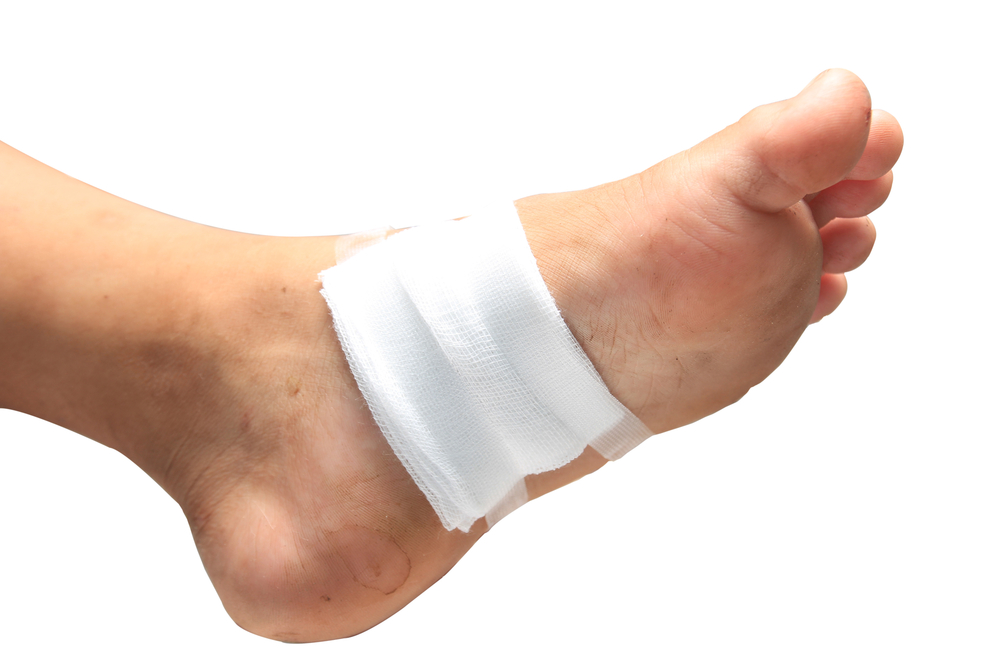 In most cases, small lacerations on the feet naturally heal without any complications. Unfortunately, this is not true for those who suffer from diabetes. Foot ulcers are a common problem for those with diabetes, because diabetic neuropathy affects their ability to feel these wounds. Diabetic neuropathy occurs as a result of nerve damage and causes numbness and pain in the hands and feet. Therefore, people with diabetes may not feel an ulcer, which will lead to it not being treated. Some signs of an ulcer are drainage, redness, swelling, and odor. An ulcer that is left untreated will worsen and black tissue called eschar might form. When tissue death occurs because of infection this is called gangrene. Both symptoms can be life-threatening and should be taken very seriously. Those with diabetes should perform daily foot checks to ensure that no ulcers have formed. If you have diabetes and would like more information about how to properly care for your feet, it is recommended you consult with a podiatrist.
In most cases, small lacerations on the feet naturally heal without any complications. Unfortunately, this is not true for those who suffer from diabetes. Foot ulcers are a common problem for those with diabetes, because diabetic neuropathy affects their ability to feel these wounds. Diabetic neuropathy occurs as a result of nerve damage and causes numbness and pain in the hands and feet. Therefore, people with diabetes may not feel an ulcer, which will lead to it not being treated. Some signs of an ulcer are drainage, redness, swelling, and odor. An ulcer that is left untreated will worsen and black tissue called eschar might form. When tissue death occurs because of infection this is called gangrene. Both symptoms can be life-threatening and should be taken very seriously. Those with diabetes should perform daily foot checks to ensure that no ulcers have formed. If you have diabetes and would like more information about how to properly care for your feet, it is recommended you consult with a podiatrist.
Wound care is an important part in dealing with diabetes. If you have diabetes and a foot wound or would like more information about wound care for diabetics, consult with one of our podiatrists from Romeo Foot & Ankle Clinic. Our doctors will assess your condition and provide you with quality foot and ankle treatment.
What Is Wound Care?
Wound care is the practice of taking proper care of a wound. This can range from the smallest to the largest of wounds. While everyone can benefit from proper wound care, it is much more important for diabetics. Diabetics often suffer from poor blood circulation which causes wounds to heal much slower than they would in a non-diabetic.
What Is the Importance of Wound Care?
While it may not seem apparent with small ulcers on the foot, for diabetics, any size ulcer can become infected. Diabetics often also suffer from neuropathy, or nerve loss. This means they might not even feel when they have an ulcer on their foot. If the wound becomes severely infected, amputation may be necessary. Therefore, it is of the upmost importance to properly care for any and all foot wounds.
How to Care for Wounds
The best way to care for foot wounds is to prevent them. For diabetics, this means daily inspections of the feet for any signs of abnormalities or ulcers. It is also recommended to see a podiatrist several times a year for a foot inspection. If you do have an ulcer, run the wound under water to clear dirt from the wound; then apply antibiotic ointment to the wound and cover with a bandage. Bandages should be changed daily and keeping pressure off the wound is smart. It is advised to see a podiatrist, who can keep an eye on it.
If you have any questions, please feel free to contact our offices located in Washington and Shelby Townships, MI . We offer the newest diagnostic and treatment technologies for all your foot care needs.
Wound Care
Diabetics must be wary of all wounds, regardless of depth or size. Diabetes, a chronic disease in which the body cannot properly use glucose the way it normally would, causes various complications that make wounds difficult to heal. Nerve damage or neuropathy will cause diabetics to have trouble feeling the pain of a blister or cut until the condition has significantly worsened or become infected. A diabetic’s weakened immune system can make even the most minor of wounds easily susceptible to infection. Diabetics are also more prone to developing narrow, clogged arteries, and are therefore more likely to develop wounds.
Wounds should be taken care of immediately after discovery, as even the smallest of wounds can become infected if enough bacteria build up within the wound. To remove dirt, wounds should be first rinsed under running water only. Soap, hydrogen peroxide, or iodine can irritate the injury and should be avoided. To prevent infection, apply antibiotic ointment to the wound and cover it with a bandage. The bandage should be changed daily. The skin around the wound may be cleaned with soap.
To prevent further exacerbation, see a doctor—especially if you have diabetes. Minor skin conditions can become larger problems if not properly inspected. As the wound heals, make sure to avoid applying pressure to the affected area.
Stretching the Feet May Aid in Foot Balance
 There are many people who stand or walk for the majority of the day, in addition to people who spend time behind a desk. There are benefits to frequently stretching the feet on a daily basis, regardless of how the day is spent. The feet will generally feel better when the toes, ankles, and arches are stretched, and certain foot conditions may be prevented as a result of proper stretching techniques that are performed. The structure of the foot is balanced and this may aid in having pain-free movements in the foot. If this balance is disturbed by having muscles that are too tight or weak, heel pain that may be indicative of plantar fasciitis may develop, or spasms may occur. An effective stretch includes pointing and flexing the foot, which may aid in loosening hamstring muscles, and adding strength to the ankles and heels. If you would like additional information about the benefits of stretching the feet, it is suggested to consult with a podiatrist.
There are many people who stand or walk for the majority of the day, in addition to people who spend time behind a desk. There are benefits to frequently stretching the feet on a daily basis, regardless of how the day is spent. The feet will generally feel better when the toes, ankles, and arches are stretched, and certain foot conditions may be prevented as a result of proper stretching techniques that are performed. The structure of the foot is balanced and this may aid in having pain-free movements in the foot. If this balance is disturbed by having muscles that are too tight or weak, heel pain that may be indicative of plantar fasciitis may develop, or spasms may occur. An effective stretch includes pointing and flexing the foot, which may aid in loosening hamstring muscles, and adding strength to the ankles and heels. If you would like additional information about the benefits of stretching the feet, it is suggested to consult with a podiatrist.
Stretching the feet is a great way to prevent injuries. If you have any concerns with your feet consult with one of our podiatrists from Romeo Foot & Ankle Clinic. Our doctors will assess your condition and provide you with quality foot and ankle treatment.
Stretching the Feet
Stretching the muscles in the foot is an important part in any physical activity. Feet that are tight can lead to less flexibility and make you more prone to injury. One of the most common forms of foot pain, plantar fasciitis, can be stretched out to help ease the pain. Stretching can not only ease pain from plantar fasciitis but also prevent it as well. However, it is important to see a podiatrist first if stretching is right for you. Podiatrists can also recommend other ways to stretch your feet. Once you know whether stretching is right for you, here are some excellent stretches you can do.
- Using a foam roller or any cylindrical object (a water bottle or soda can will do), roll the object under your foot back and forth. You should also exert pressure on the object. Be sure to do this to both feet for a minute. Do this exercise three times each.
- Similar to the previous one, take a ball, such as a tennis ball, and roll it under your foot while seated and exert pressure on it.
- Grab a resistance band or towel and take a seat. If you are using a towel, fold it length wise. Next put either one between the ball of your foot and heel and pull with both hands on each side towards you. Hold this for 15 seconds and then switch feet. Do this three times for each foot.
- Finally hold your big toe while crossing one leg over the other. Pull the toe towards you and hold for 15 seconds. Once again do this three times per foot.
It is best to go easy when first stretching your foot and work your way up. If your foot starts hurting, stop exercising and ice and rest the foot. It is advised to then see a podiatrist for help.
If you have any questions, please feel free to contact our offices located in Washington and Shelby Townships, MI . We offer the newest diagnostic and treatment technologies for all your foot care needs.
How to Stretch Your Feet
Your feet endure a great amount of stress each day from constantly allowing us to move around. It is important to stretch your feet to help prevent them from becoming injured. Your toes may easily deform into unhealthful positions if they are not stretched.
One of the most common reasons for toe deformities are the shoes you may be wearing. Shoes that are too tight may fold and shift the toes out of place. Heeled shoes may also push your toes upward. Forcing your toes into an unnatural position which may cause the muscles to tighten and prevent them from reverting to normal length. Another common reason is improper use of foot muscles. Many people fail to use the muscles in their feet or toes when they walk. Lastly, the positioning of your feet while walking may also cause toe deformities. If you walk with your feet facing outward, your “push-off” phase is on the side of your big toe instead of the bottom of your foot. This may cause the big toe to eventually tighten into a new shifted position.
There are many reasons why stretching your toes may be helpful. One reason is that healthy spacing may aid in avoiding calluses and other injuries that are caused by rubbing. Stretching will also prevent you from developing toes that curl, hammertoes, or bunions.
A great way to stretch your toes is to place them in your hands and bend them all downward; this will help you stretch the top of your foot. Next, you should repeat this process but instead bend them upward enough to feel a nice stretch in the bottom of your foot. You should then try to pull each toe apart from the next and pull any toes that are bent upward until they are back downward.
If you are looking to practice stretching your entire foot, you can try a towel stretch. This is done by sitting on the floor with your legs in front of you. Take a towel and wrap it around your toes. Afterward, pull the towel toward you with your toes and hold this position for 15 to 30 seconds before releasing. Practice this stretch for three sets. Another stretch your feet are towel lifts. This is done by sitting in a chair and trying to pick a towel up from the ground with your toes. Try lifting the towel with your little toes for five sets before switching feet.
If you are an athlete, or exercise often, it is especially important for you to practice stretching your feet. Those who suffer from foot pain caused by poor footwear, plantar fasciitis, or long hours of standing at work may also benefit from foot exercises.
Treating Plantar Fasciitis with Shockwave Therapy
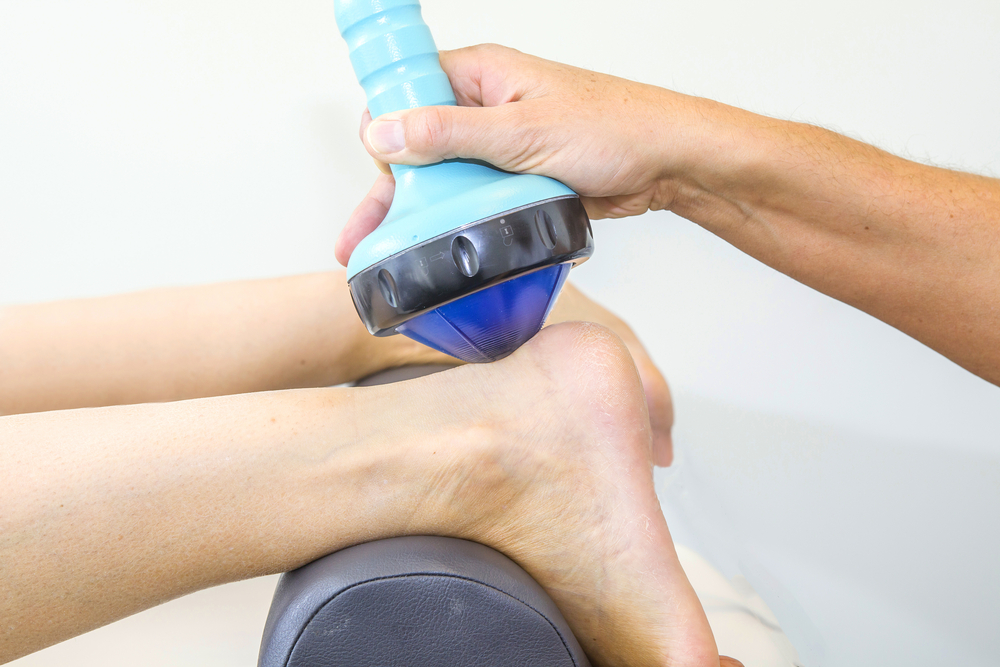 Plantar fasciitis is a common foot condition that affects the heel and causes striking pain outward. This condition occurs when the connective tissue, plantar fascia, which runs along the underside of the foot, is injured or inflamed. It is most common in those who participate in activities like running that cause repetitive impact on the feet. Most of the time it can be treated with simple remedies that do not require surgery, but some severe cases require further action. Surgery is rare, but can be invasive, so many doctors are turning to alternative therapies. Shockwave therapy helps to trigger the repair and regrowth of the injured nerve. The plantar fascia is located in an area of the foot that does not receive much blood flow, which impedes on the its ability to heal itself. Shockwave therapy helps to pull blood to the plantar fascia to facilitate repairing the nerve. If you have plantar fasciitis, it is highly recommended to speak with a podiatrist about your treatment options.
Plantar fasciitis is a common foot condition that affects the heel and causes striking pain outward. This condition occurs when the connective tissue, plantar fascia, which runs along the underside of the foot, is injured or inflamed. It is most common in those who participate in activities like running that cause repetitive impact on the feet. Most of the time it can be treated with simple remedies that do not require surgery, but some severe cases require further action. Surgery is rare, but can be invasive, so many doctors are turning to alternative therapies. Shockwave therapy helps to trigger the repair and regrowth of the injured nerve. The plantar fascia is located in an area of the foot that does not receive much blood flow, which impedes on the its ability to heal itself. Shockwave therapy helps to pull blood to the plantar fascia to facilitate repairing the nerve. If you have plantar fasciitis, it is highly recommended to speak with a podiatrist about your treatment options.
Shockwave therapy is a treatment commonly used to treat various injuries and conditions, particularly plantar fasciitis in the feet. To learn more, consult with one of our podiatrists from Romeo Foot & Ankle Clinic. Our doctors can provide the care you need to keep you pain-free and on your feet.
Shockwave Therapy
Shockwave therapy is a new treatment option designed to treat bone conditions such as tennis elbow, shoulder pain, and others. Shockwave therapy uses high intensity sound waves that are directed to the affected tissues of the body with pinpoint accuracy. The effects are very beneficial, leading to a production of collagen fibers, eliminating inflammation.
Who Benefits from Shockwave?
Shockwave is recommended for patients suffering from heel pain and associated problems. Heel pain is a common condition which can be caused by obesity, overexertion, and spending a substantial amount of time on hard floors with your feet exposed and unsupported.
Fast and Easy
The therapy is actually a simple process that can leave patients feeling better the very next day. Shockwave therapy is not as dramatic as it sounds. It enables more blood flow to effected areas, addressing the source of the problem and allowing treatment to last for a long time.
Treatment & Recovery Time
Shockwave treatment will enable your feet to recover quickly. This is especially important since surgery is not required. It is cost effective and does not require the use of anesthesia. This treatment is a better option to surgery, since it is proven safe.
If you have any questions, please feel free to contact our offices located in Washington and Shelby Townships, MI . We offer the newest diagnostic and treatment technologies for all your foot and ankle needs.
Treating Heel Pain with Shockwave Therapy
Shockwave therapy is one treatment option for plantar fasciitis, a condition that causes heel and foot inflammation and pain. This type of injury is often caused by overworking the feet. Heel pain is most common in people that exercise often, individuals who are overweight, and people whose profession require them to stand for long periods of time.
Heel pain can be caused by a number of problems including ill-fitting shoes, strenuous exercise routines or work hazards. Simple treatment options involve buying new shoes, taking ibuprofen, doing heel and foot exercises, and resting your feet. For severe cases, shockwave therapy can be considered a more viable form of treatment.
Shockwave therapy should be considered for patients that have had unsuccessful treatment or whose heel pain has lasted for more than six months. In shockwave therapy, a device delivers shockwaves to the patient’s body, which jumpstart the body’s repair mechanisms. These mechanisms then begin working more effectively to repair damage done to the heel area.
Shockwave therapy also helps eliminate pain in the heel area. When the body’s natural repair mechanisms are triggered, tissue healing in the body is sped up. This leads to pain reduction after pain transmission nerves are stimulated.
Shockwave therapy eliminates the risk factors associated with surgery, such as the use of anesthetics, and is less invasive. Since this technique also helps improve the body’s natural healing techniques, recovery time should be shorter than surgical procedures.
Discomfort issues can also be a side effect of treatment. Short-term issues normally include skin bruising, minor pain during and after treatment, swelling of the heel, and discolored tissue. However, these side effects of shockwave therapy usually disappear after a few days. The fast recovery time of shockwave therapy makes it easy for patients to return to their daily routines.
Like most types of treatments, surgeries, and medications, shockwave therapy is not for everyone. Potential patients with heart conditions and people with pacemakers should not be considered for this technique. People on certain types of medications, usually medications affecting blood clotting, would be ineligible for shockwave therapy. Children and pregnant women should avoid this treatment option as well.
Overall, shockwave therapy could be a great option for heel pain. It is less invasive than surgery, helps trigger natural healing mechanisms, and should be considered by people who have had long bouts of heel pain or tried conventional treatment options that were unsuccessful.



